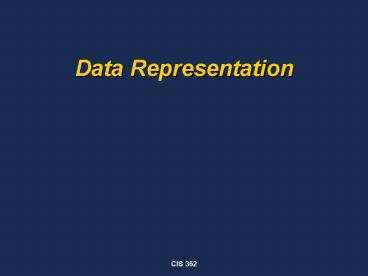Data Representation PowerPoint PPT Presentation
1 / 29
Title: Data Representation
1
Data Representation
2
Overview
- To frame our discussion, consider
3
Outline
- Activities
- Types of Data
- Representations
- Guidelines
4
Research Activities
- Data Gathering
- Data Summarization
- Data Interpretation
5
Types of Data
- Nominal
- Ordinal
- Discrete
- Continuous
6
Representations
- Pie Charts
- Bar Charts
- Pareto Diagrams
- Frequency Distributions
- Stem-and-Leaf Plots
- Scatter Plots
- Box Plots
- Time Series
7
Pie Charts
- The pie chart is appropriate for displaying
nominal and ordinal data. The pie chart shows the
percentage of the total measurements that fall in
a certain category.
8
Example
9
Bar/Column Charts
- Bar/Column charts are also useful in displaying
nominal and ordinal data. The bar chart can
display either percentages, as the pie chart did,
or the number of measurements in a category.
10
Example (1)
11
Example (2)
12
Example (3)
13
Pareto Diagrams
- Pareto diagrams are named after Vilfredo Pareto,
an Italian sociologist and economist, who
invented this method of information presentation
toward the end of the 19th century. - The chart is similar to the histogram or bar
chart, except that the bars are arranged in
decreasing magnitude from left to right along the
abscissa.
14
Pareto Diagrams
- The fundamental idea behind the use of Pareto
diagrams for quality improvement is that the
first few (as presented on the diagram)
contributing causes to a problem usually account
for the majority of the result. Thus,
targeting these "major causes" for elimination
results in the most cost-effective improvement
scheme.
15
Example
From Harnessing the Power of the Pareto
Principle, www.shawresources.com
16
Frequency Distributions
- Frequency histograms are used representing
discrete or continuous data. - The range of measures, max minus min, is used to
construct class intervals. Class intervals all
have the same range. - To avoid assignment problems, choose endpoints
for the class intervals that have one more digit
of precision than the data. - The number of classes is chosen based on the size
of the data set, and the granularity you wish to
portray.
17
Example
18
Stem-and-Leaf Plots
- For small data sets, a stem-and-leaf plot
presents the distribution quickly without loss of
information. - Separate each observation into two parts, a stem,
consisting of the leftmost digit(s), and a leaf,
the rightmost digit(s). - Beginning with the smallest stem write the stems
in a vertical column. - Write each leaf in the row to right of its stem,
in increasing order.
19
Stem-and- Leaf Displays
- Select one or more leading digits for the stem
values. The trailing digits become the leaves. - List stem values in a vertical column.
- Record the leaf for every observation.
- Indicate the units for the stem and leaf on the
disply.
20
Stem-and-Leaf Example
Observed values
9, 10, 15, 22, 9, 15, 16, 24,11
- 0 9 9
- 1 0 5 5 6
- 2 4
Stem tens digit
Leaf units digit
21
Example
22
Relating Variables
- Most studies involve more than one variable. We
need a way to represent data so we can look for
relationships.
23
Scatterplot
- A scatterplot shows the relationship between two
quantitative variables measured on the same
individual.
24
Example
25
Interpreting the Scatterplot
- Look at
- Form
- Do the data points form a shape?
- Direction
- Does the shape formed indicate a direction?
- Strength
- Is there little scatter about the shape?
26
Associations
- Two variables can be either
- Positively associated
- Or
- Negatively associated
27
Positively Associated
- Two variables are positively associated when
above average values in one variable results in
above average values in the other.
28
Example (2)
29
Choosing a Representation
- Set priorities.
- Who is the audience?
- What is the message?
- Choose the graph type.
- Set the title to inform the reader of the
purpose. - Use color to convey tone (warm tones are dramatic
whereas pastels are conservative).

